小升初英语复习计划
图片预览
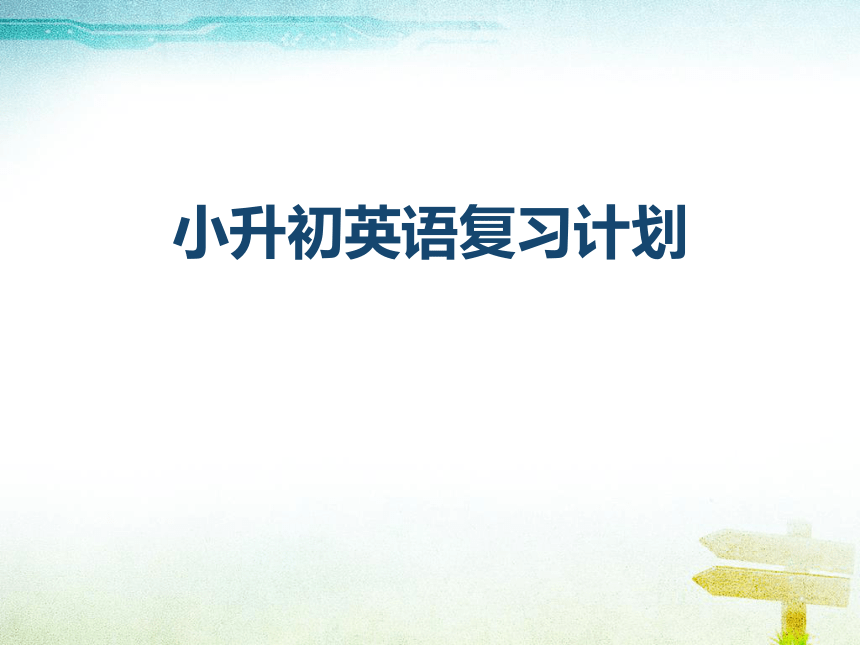
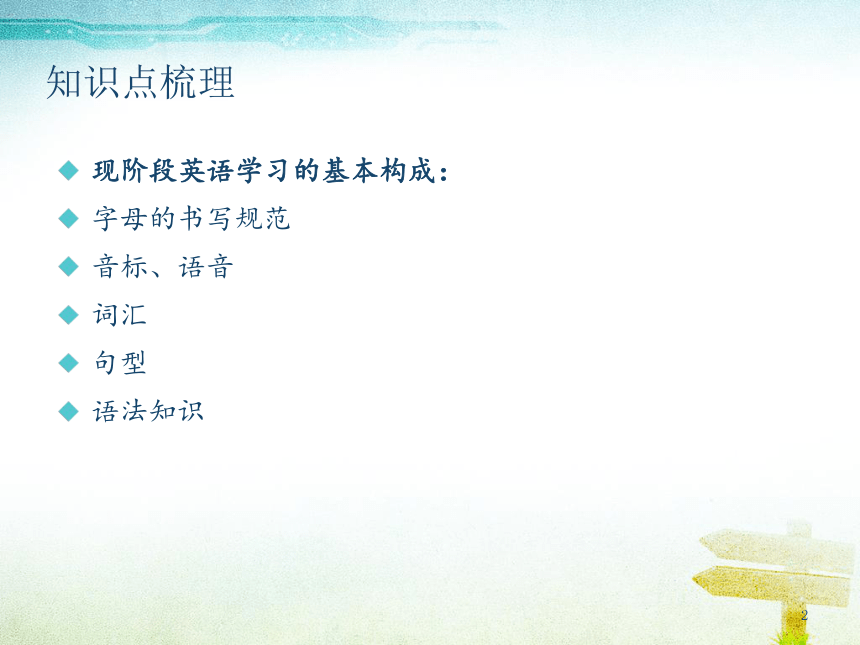
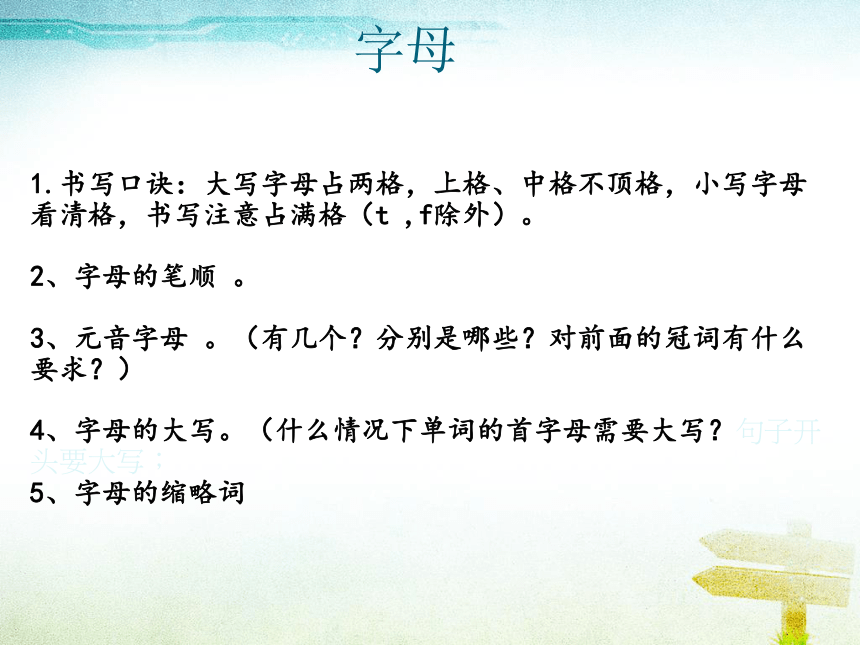
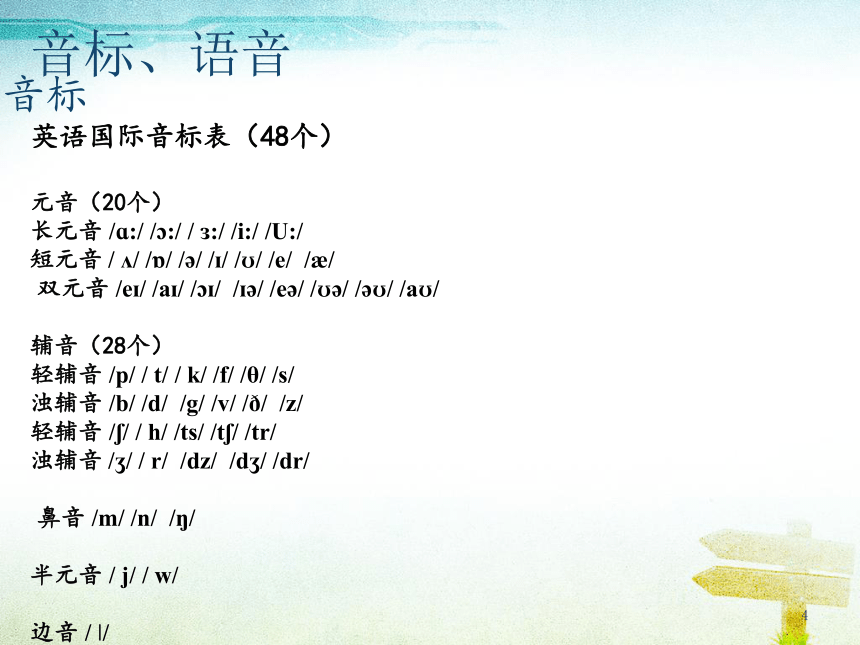
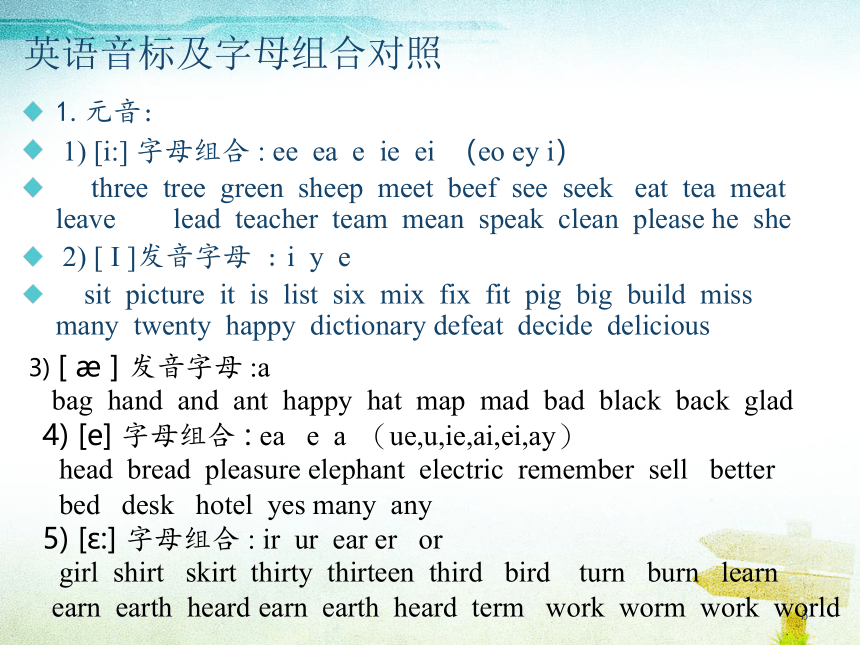
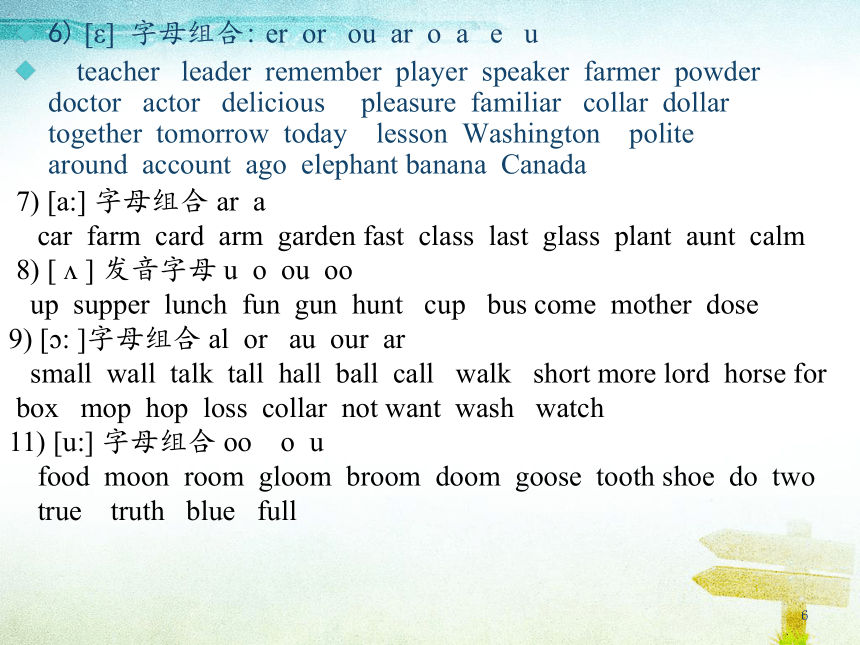
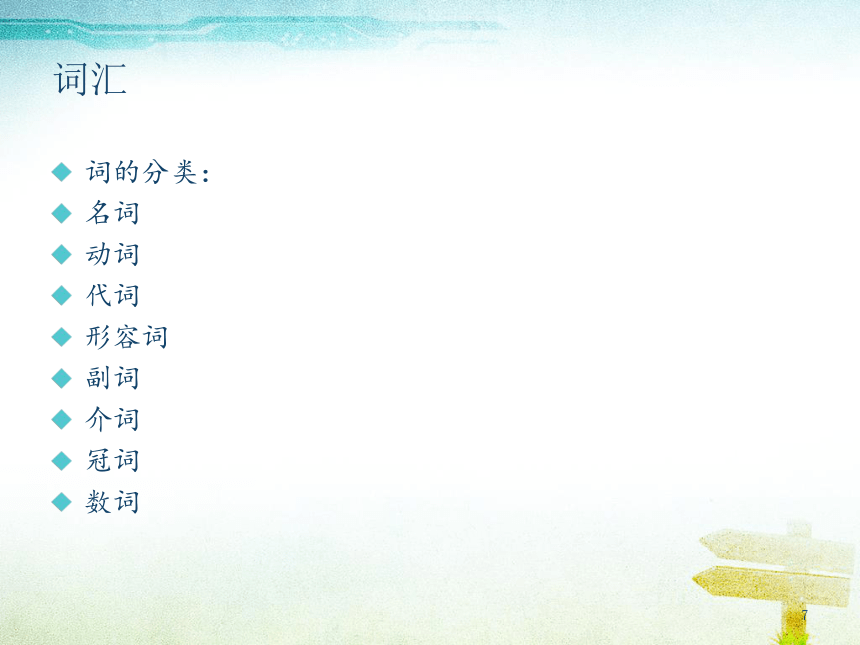
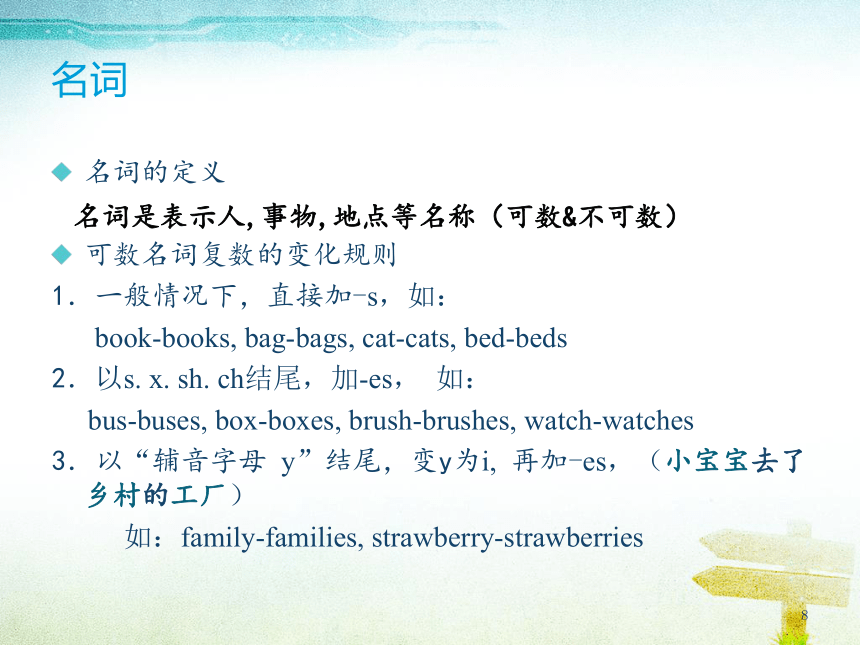
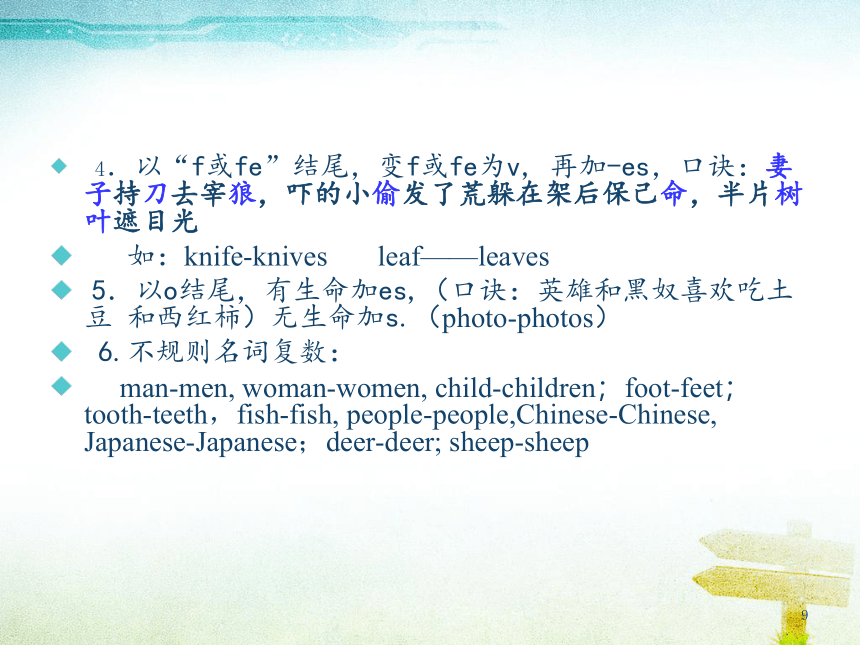
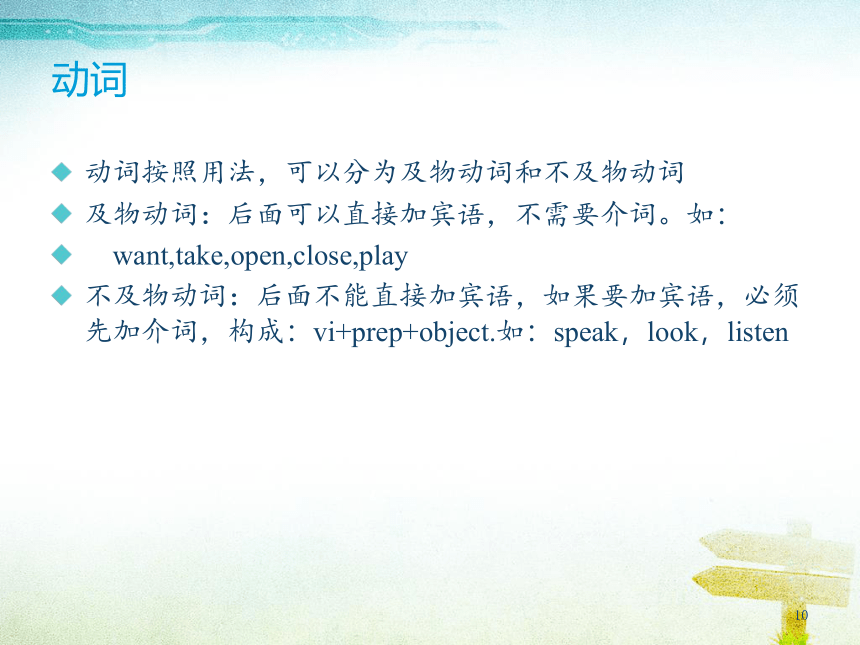

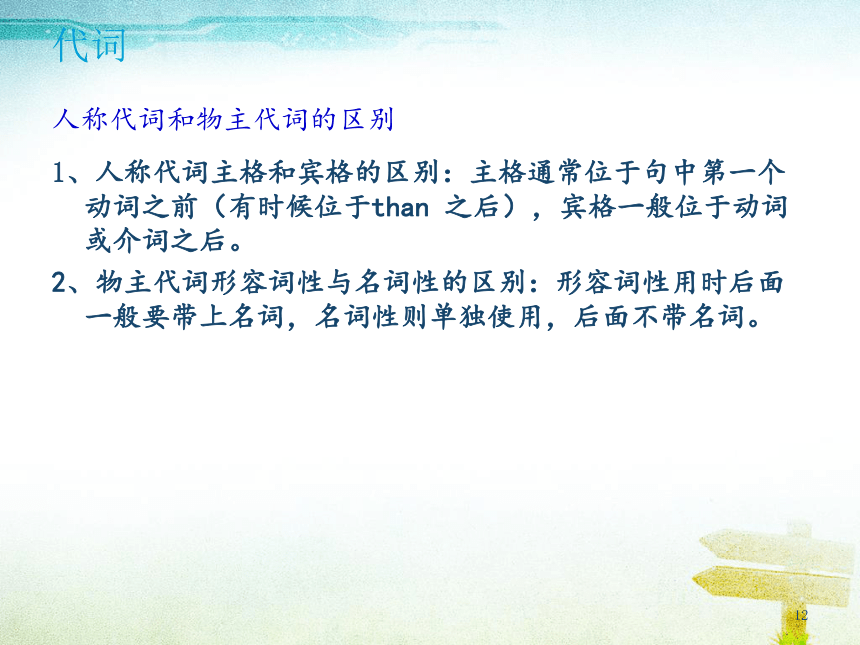
文档简介
课件39张PPT。小升初英语复习计划1知识点梳理现阶段英语学习的基本构成:
字母的书写规范
音标、语音
词汇
句型
语法知识
字母1.书写口诀:大写字母占两格,上格、中格不顶格,小写字母看清格,书写注意占满格(t ,f除外)。
2、字母的笔顺 。
3、元音字母 。(有几个?分别是哪些?对前面的冠词有什么要求?)
4、字母的大写。(什么情况下单词的首字母需要大写?句子开头要大写;
5、字母的缩略词1音标、语音音标
英语国际音标表(48个)?
元音(20个)?
长元音?/ɑ:/?/?:/?/??:/?/i:/?/U:/??
短元音?/??/?/?/?/?/?/?/?/?/?/e/??/?/
?双元音?/e?/?/a?/?/??/??/??/?/e?/?/??/?/??/?/a?/
辅音(28个)?
轻辅音?/p/?/?t/?/?k/?/f/?/θ/?/s/?
浊辅音?/b/?/d/??/g/?/v/?/e/??/z/??
轻辅音?/?/?/?h/?/ts/?/t?/?/tr/???
浊辅音?/?/?/?r/??/dz/??/d?/?/dr/??
?鼻音?/m/?/n/??/?/??????
?
半元音?/?j/?/?w/??
?
边音?/??/1英语音标及字母组合对照 1.元音:
1) [i:] 字母组合 : ee ea e ie ei (eo ey i)
three tree green sheep meet beef see seek eat tea meat leave lead teacher team mean speak clean please he she
2) [ I ]发音字母 : i y e
sit picture it is list six mix fix fit pig big build miss many twenty happy dictionary defeat??decide??delicious?
3)?[???]?发音字母?:a?
bag??hand??and??ant??happy??hat??map??mad??bad??black??back??glad??
4)?[e]?字母组合?: ea???e??a??(ue,u,ie,ai,ei,ay)?
head??bread??pleasure elephant??electric??remember??sell???better??
?bed???desk???hotel??yes?many??any??
5)?[ε:]?字母组合 : ir??ur??ear?er???or?
girl??shirt???skirt??thirty??thirteen??third???bird??? turn???burn???learn?
?earn??earth??heard earn earth heard term work worm work world16) [ε] 字母组合: er or ou ar o a e u
teacher leader remember player speaker farmer powder doctor actor delicious pleasure familiar collar dollar together tomorrow today lesson Washington polite around account ago elephant banana Canada
7)?[a:]?字母组合?ar??a?
car??farm??card??arm??garden?fast??class??last??glass??plant??aunt??calm?
?8)?[???]?发音字母?u??o??ou??oo???
up??supper??lunch??fun??gun??hunt???cup???bus?come??mother??dose?
9)?[?:?]字母组合?al??or???au??our??ar?
small??wall??talk??tall??hall??ball??call???walk???short?more?lord??horse?for??
?box???mop??hop??loss??collar??not?want??wash???watch??
11)?[u:]?字母组合?oo????o??u?
food??moon??room??gloom??broom??doom??goose??tooth?shoe??do??two?
true????truth???blue???full???
???1词汇词的分类:
名词
动词
代词
形容词
副词
介词
冠词
数词1名词名词的定义
可数名词复数的变化规则
1.一般情况下,直接加-s,如:
book-books, bag-bags, cat-cats, bed-beds
2.以s. x. sh. ch结尾,加-es, 如:
bus-buses, box-boxes, brush-brushes, watch-watches
3.以“辅音字母 y”结尾,变y为i, 再加-es,(小宝宝去了乡村的工厂)
如:family-families, strawberry-strawberries
名词是表示人,事物,地点等名称(可数&不可数) 1 4.以“f或fe”结尾,变f或fe为v, 再加-es,口诀:妻子持刀去宰狼,吓的小偷发了荒躲在架后保己命,半片树叶遮目光
如:knife-knives ??????leaf——leaves
?5.以o结尾,有生命加es,(口诀:英雄和黑奴喜欢吃土豆 和西红柿)无生命加s.(photo-photos)
6.不规则名词复数:
man-men, woman-women, child-children;foot-feet; tooth-teeth,fish-fish, people-people,Chinese-Chinese, Japanese-Japanese;deer-deer; sheep-sheep
1动词动词按照用法,可以分为及物动词和不及物动词
及物动词:后面可以直接加宾语,不需要介词。如:
want,take,open,close,play
不及物动词:后面不能直接加宾语,如果要加宾语,必须先加介词,构成:vi+prep+object.如:speak,look,listen1练习
I _____him ______ this _______ her _____
watch ___ child ____photo ______diary _____day______ foot_____ book_____ dress ____
tooth____ sheep ____ box_____ strawberry __ thief _____you _____ peach___ sandwich ___man_____ woman___ paper_____ juice_____water_____ milk______ rice______ tea______ 1代词 人称代词和物主代词的区别1、人称代词主格和宾格的区别:主格通常位于句中第一个动词之前(有时候位于than 之后),宾格一般位于动词或介词之后。
2、物主代词形容词性与名词性的区别:形容词性用时后面一般要带上名词,名词性则单独使用,后面不带名词。?1代词及Be动词的用法Ime1练习用所给词的适当形式填空。
1.?That is not _____kite. That kite is very small,
but ____is very big.??( I )
2.?The dress is ____. Give it to _____( she )? ?? ???
3.?___is my brother. ___ name is Jack. Look!
Those stamps are___ ( he )
4.?I can find my toy, but where’s ______? ( you )
5.?Show _________ your kite, OK? (they)1用am,is,are填空。
1. That ______ my red skirt.
2. Who ______ I?
3.The jeans ______ on the desk.
4. The black gloves ______??for Su Yang.
5. This pair of gloves ______ for Yang Ling.
6. The two cups of milk _____ for me.
7. Some tea ______ in the glass. 1形容词和副词 形容词比较级在句子中的运用:两个事物或人的比较用比较级,比较级后面一般带有单词than。比较级前面可以用more, a little 来修饰表示程度。than后的人称代词用主格(口语中可用宾格)。少数以-er,-ow结尾的双音节词可加-er或-est1不规则变化good/well-better,best
bad/ill-worse,worst
many/much-more,most
little-less,least
far-farther/further,farthest/furthest
old-older/elder,oldest/eldest1练习一、写出下列形容词或副词的比较级 ? short________?strong______? ?big_____ ?small_______ ??fat_________? ?thin_________?heavy____? ?light________ ??nice________ ?good_______? ?beautiful_______________ ??low_________?high________? slow_______??fast________ ??late_________?early________ ?far_________ well_______ 二、根据句意填入单词的正确形式: 1. My brother is two years __________(old) than me. 2. Tom is as ________(fat) as Jim. 3. Is your sister __________(young) than you? Yes, she is. 4. Who is ___________(thin), you or Helen? Helen is.
15.______Nancy sing _____(well) than Helen?
Yes, she ___. 6.Fangfang is not as ____(tall) as the other girls.
7.My eyes are __________(big) than _____ (she)
8.Who gets up _________(early), Tim or Tom? 9._____the girls get up ______(early) than the
boys? No, they______.1冠词不定冠词与定冠词不定冠词的用法冠词a、an两帽,
许多名词都需要
开头读音若是元。
要把an帽来挑选。
辅音起首戴a帽。
记住规律很重要。1数词基数词
序数词:记忆口诀1There be句型意义:表示存在。某处有某物。
构成:there+be动词(否定和疑问形式)
1.否定be 后not 填(否定变形要先找到be 然后在be 后面加个not)
2.疑问提be there 前(疑问也是先找到be 然后把be 提到there 前面)
3.疑否(疑问和否定句)用any替换some
4.单数复数就进选(就近原则)
1There be 句型与have, has的区别 1、There be 句型表示:在某地有某人/物
2、在there be 句型中,主语是单数,be 动词用is ; 主语是复数,be 动词用are ; 如有几件物品,be 动词根据最近be 动词的那个名词决定。 3、there be 句型的否定句在be 动词后加not , 一般疑问句把be 动词调到句首。 4、there be句型与have(has) 的区别:there be表示在某地有某人/物;have(has)表示某人拥有某物。
1练习用 “have, has”or “there is , there are” 填空
1. I ________ a good father and a good mother.
2. ____________a telescope on the desk.
3. He_________ a tape-recorder.
4. ____________a basketball in the playground.
5. She__________ some dresses. 1语法一般现在时
一般现在时基本用法介绍
1.一般现在时的功能
1).表示事物或人物的特征、状态。
如:The sky is blue.天空是蓝色的。
2).表示经常性或习惯性的动作。
如:I get up at six every day.我天天六点起床。
3).表示客观现实。
如:The earth goes around the sun.地球绕着太阳转12.一般现在时的构成
1). be动词:主语 be (am, is, are) 其它。如:
I am a boy.我是一个男孩。
2).行为动词:主语 行为动词( 其它)。如:
?We study English.我们学习英语。
当主语为第三人称单数(he, she, it)时,要在动词 后加“-s”或“-es”
如:Mary likes Chinese.玛丽喜欢汉语。13.一般现在时的变化 1). be动词的变化。
? 否定句:主语 be not 其它。
如:He is not a worker.他不是工人。
? 一般疑问句:Be 主语 其它。
? 如:-Are you a student?
? -Yes. I am. / No, I'm not.
? 特殊疑问句:疑问词 一般疑问句。
如:Where is my bike?
12).行为动词的变化 否定句:主语 don't( doesn't ) 动词原形( 其它)。
如:?I don't like bread.
当主语为第三人称单数,用doesn't构成否定句
如:He doesn't often play.
一般疑问句:Do( Does ) 主语 动词原形 其它。
如- Do you often play football?
? - Yes, I do. / No, I don't.
当主语为第三人称单数,要用does构成一般疑问句 - 如 -Does she go to work by bike?
- Yes, she does. / No, she doesn't.1 3.动词 s的变化规则?
1.一般情况下,直接加-s,
如:cook-cooks, milk-milks
?2.以s. x. sh. ch. o结尾,加-es,
如:guess-guesses, wash-washes,
watch-watches, go-goes
? 3.以“辅音字母 y”结尾,变y为i, 再加-es,
如study-studies1练习 按照要求改写句子 1. Daniel watches TV every evening.(改为否定句) ___________________________________________________ 2. I do my homework every day.(改为一般疑问句,作否定回答) ________________________________________________________ 3. She likes milk.(改为一般疑问句,作肯定回答) ___________________________? 4. We go to school every morning.(改为否定句) ___________________________________________________ 五、改错(划出错误的地方,将正确的写在横线上) 1. Is??your brother speak English?? ?? ?__________________ 2. Does he likes going fishing?? ?? ?? ? _________________ 3. He likes play games after class.? ? ? _________________ 4. Mr. Wu teachs us English.? ?? ?? ?? ? __________________ 5. She don’t do her homework on Sundays. _______________1现在进行时1、现在进行时表示现在正在进行或发生的动作,也可表示当前一段时间内的活动或现阶段正在进行的动作。
2、现在进行时的肯定句基本结构为be 动词ing.
3、现在进行时的否定句在be后加not。
4、现在进行时的一般疑问句把be动词调到句 首。
5、现在进行时的特殊疑问的基本结构为:
疑问词+be动词+主语+doing+其它?
但疑问词当主语时其结构为:
? 疑问词+be动词+doing+其它?1 动词加ing的变化规则
1.一般情况下,直接加ing,
如:cook-cooking
2.以不发音的e结尾,去e加ing,
如:make-making, taste-tasting
3.假如末尾是一个元音字母和一个辅音字母, 双写末尾的辅音字母,再加ing如:run-running, stop-stopping1练习现在进行时专项练习: 一、写出下列动词的现在分词: run_______ swim _______make______ begin______ go________ like________??write______ shop ______have ______sing??______dance ______put________
see_______ love_______ live_______ take________
come _____??get _______stop_______ sit ________
二、用所给的动词的正确形式填空: 1.The boy _________________( draw) a picture now. 2. Listen .Some girls _____( sing) in the classroom . 3. My mother ________( cook )some nice food??now. 4. What _____ you ______ ( do ) now? 5. Look . They __________( have) an English lesson .1一般将来时一、概念:表示将要发生的动作或存在的状态及 打算、计划或预备做某事。句中一般有以下时间状语:tomorrow, next day (week, month, year…),soon, the day after tomorrow(后天)等。 ?
二、基本结构:①be going to do;②will do.
三、否定句:在be动词(am, is, are)l后加not或情态动词will后加not成won’t。
例如:I’m going to have a picnic this afternoon.→ I’m not going to have a picnic this afternoon.
四、一般疑问句: be或will提到句首,some改为any, and改为or,第一二人称互换。 例如:We are going to go on an outing this weekend. → Are you going to go on an outing this weekend1练习填空。
1.??我打算明天和朋友去野炊。
I_____ _______ _________ have a picnic with my friends. I ________ have a picnic with my friends.
2.?下个星期一你打算去干嘛? 我想去打篮球。 What ________ ________ _________ _________ ______next
Monday? I _______ ______ _____ play basketball.(同义句
3. 你妈妈这个周末去购物吗?是,她要去买一些水果。 _____ your mother _____ ____ go shopping this _______?
Yes, she _________. She ______ ________ __________
buy some fruit.
4. 你们打算什么时候见面。 What time ______ you ______ ________ meet?1一般过去时
1.一般过去时表示过去某个时间发生的动作或 存在的状态,常和表示过去的时间状语连用。一般过去时也表示过去经常或反复发生的动作。
2.Be动词在一般过去时中的变化:
⑴am 和is在一般过去时中变为was(was not=wasn’t)
⑵are在一般过去时中变为were。(were not=weren’t)
3.句中没有be动词的一般过去时的句子
否定句:didn’t 动词原形,
如:Jim didn’t go home yesterday.1动词过去式变化规则
1.一般在动词末尾加-ed,如:work- -worked ,
?2.结尾是e加d,如:live--lived
3.末尾只有一个元音字母和一个辅音字母的重读闭音节,应双写末尾的辅音字母,再加-如:stop-stopped
?4.以“辅音字母 y”结尾的,变y为i, 再加-ed,如:study-studied15.不规则动词过去式:
?am、is-was, are-were, do-did
see-saw, say-said, give-gave, get-got
go-went, come-came, have-had, eat-ate
take-took, run-ran, sing-sang, put-put,
make-made, read-read, write-wrote,
draw-drew, drink-drank, swim-swam, sit-sat1?用动词的适当形式填空 1. It ______ (be) Ben’s birthday last Friday. 2. We all ______ (have) a good time last night. 3. He ________ (jump) high on last Sports Day. 4. Helen ________ (milk) a cow on Friday. 5. She likes ______ newspapers, but she _____a book yesterday. (read) 6. _______ they ________ (sweep) the floor on Sunday? No, they _____. 7. I _______ (watch) a cartoon on Monday.
字母的书写规范
音标、语音
词汇
句型
语法知识
字母1.书写口诀:大写字母占两格,上格、中格不顶格,小写字母看清格,书写注意占满格(t ,f除外)。
2、字母的笔顺 。
3、元音字母 。(有几个?分别是哪些?对前面的冠词有什么要求?)
4、字母的大写。(什么情况下单词的首字母需要大写?句子开头要大写;
5、字母的缩略词1音标、语音音标
英语国际音标表(48个)?
元音(20个)?
长元音?/ɑ:/?/?:/?/??:/?/i:/?/U:/??
短元音?/??/?/?/?/?/?/?/?/?/?/e/??/?/
?双元音?/e?/?/a?/?/??/??/??/?/e?/?/??/?/??/?/a?/
辅音(28个)?
轻辅音?/p/?/?t/?/?k/?/f/?/θ/?/s/?
浊辅音?/b/?/d/??/g/?/v/?/e/??/z/??
轻辅音?/?/?/?h/?/ts/?/t?/?/tr/???
浊辅音?/?/?/?r/??/dz/??/d?/?/dr/??
?鼻音?/m/?/n/??/?/??????
?
半元音?/?j/?/?w/??
?
边音?/??/1英语音标及字母组合对照 1.元音:
1) [i:] 字母组合 : ee ea e ie ei (eo ey i)
three tree green sheep meet beef see seek eat tea meat leave lead teacher team mean speak clean please he she
2) [ I ]发音字母 : i y e
sit picture it is list six mix fix fit pig big build miss many twenty happy dictionary defeat??decide??delicious?
3)?[???]?发音字母?:a?
bag??hand??and??ant??happy??hat??map??mad??bad??black??back??glad??
4)?[e]?字母组合?: ea???e??a??(ue,u,ie,ai,ei,ay)?
head??bread??pleasure elephant??electric??remember??sell???better??
?bed???desk???hotel??yes?many??any??
5)?[ε:]?字母组合 : ir??ur??ear?er???or?
girl??shirt???skirt??thirty??thirteen??third???bird??? turn???burn???learn?
?earn??earth??heard earn earth heard term work worm work world16) [ε] 字母组合: er or ou ar o a e u
teacher leader remember player speaker farmer powder doctor actor delicious pleasure familiar collar dollar together tomorrow today lesson Washington polite around account ago elephant banana Canada
7)?[a:]?字母组合?ar??a?
car??farm??card??arm??garden?fast??class??last??glass??plant??aunt??calm?
?8)?[???]?发音字母?u??o??ou??oo???
up??supper??lunch??fun??gun??hunt???cup???bus?come??mother??dose?
9)?[?:?]字母组合?al??or???au??our??ar?
small??wall??talk??tall??hall??ball??call???walk???short?more?lord??horse?for??
?box???mop??hop??loss??collar??not?want??wash???watch??
11)?[u:]?字母组合?oo????o??u?
food??moon??room??gloom??broom??doom??goose??tooth?shoe??do??two?
true????truth???blue???full???
???1词汇词的分类:
名词
动词
代词
形容词
副词
介词
冠词
数词1名词名词的定义
可数名词复数的变化规则
1.一般情况下,直接加-s,如:
book-books, bag-bags, cat-cats, bed-beds
2.以s. x. sh. ch结尾,加-es, 如:
bus-buses, box-boxes, brush-brushes, watch-watches
3.以“辅音字母 y”结尾,变y为i, 再加-es,(小宝宝去了乡村的工厂)
如:family-families, strawberry-strawberries
名词是表示人,事物,地点等名称(可数&不可数) 1 4.以“f或fe”结尾,变f或fe为v, 再加-es,口诀:妻子持刀去宰狼,吓的小偷发了荒躲在架后保己命,半片树叶遮目光
如:knife-knives ??????leaf——leaves
?5.以o结尾,有生命加es,(口诀:英雄和黑奴喜欢吃土豆 和西红柿)无生命加s.(photo-photos)
6.不规则名词复数:
man-men, woman-women, child-children;foot-feet; tooth-teeth,fish-fish, people-people,Chinese-Chinese, Japanese-Japanese;deer-deer; sheep-sheep
1动词动词按照用法,可以分为及物动词和不及物动词
及物动词:后面可以直接加宾语,不需要介词。如:
want,take,open,close,play
不及物动词:后面不能直接加宾语,如果要加宾语,必须先加介词,构成:vi+prep+object.如:speak,look,listen1练习
I _____him ______ this _______ her _____
watch ___ child ____photo ______diary _____day______ foot_____ book_____ dress ____
tooth____ sheep ____ box_____ strawberry __ thief _____you _____ peach___ sandwich ___man_____ woman___ paper_____ juice_____water_____ milk______ rice______ tea______ 1代词 人称代词和物主代词的区别1、人称代词主格和宾格的区别:主格通常位于句中第一个动词之前(有时候位于than 之后),宾格一般位于动词或介词之后。
2、物主代词形容词性与名词性的区别:形容词性用时后面一般要带上名词,名词性则单独使用,后面不带名词。?1代词及Be动词的用法Ime1练习用所给词的适当形式填空。
1.?That is not _____kite. That kite is very small,
but ____is very big.??( I )
2.?The dress is ____. Give it to _____( she )? ?? ???
3.?___is my brother. ___ name is Jack. Look!
Those stamps are___ ( he )
4.?I can find my toy, but where’s ______? ( you )
5.?Show _________ your kite, OK? (they)1用am,is,are填空。
1. That ______ my red skirt.
2. Who ______ I?
3.The jeans ______ on the desk.
4. The black gloves ______??for Su Yang.
5. This pair of gloves ______ for Yang Ling.
6. The two cups of milk _____ for me.
7. Some tea ______ in the glass. 1形容词和副词 形容词比较级在句子中的运用:两个事物或人的比较用比较级,比较级后面一般带有单词than。比较级前面可以用more, a little 来修饰表示程度。than后的人称代词用主格(口语中可用宾格)。少数以-er,-ow结尾的双音节词可加-er或-est1不规则变化good/well-better,best
bad/ill-worse,worst
many/much-more,most
little-less,least
far-farther/further,farthest/furthest
old-older/elder,oldest/eldest1练习一、写出下列形容词或副词的比较级 ? short________?strong______? ?big_____ ?small_______ ??fat_________? ?thin_________?heavy____? ?light________ ??nice________ ?good_______? ?beautiful_______________ ??low_________?high________? slow_______??fast________ ??late_________?early________ ?far_________ well_______ 二、根据句意填入单词的正确形式: 1. My brother is two years __________(old) than me. 2. Tom is as ________(fat) as Jim. 3. Is your sister __________(young) than you? Yes, she is. 4. Who is ___________(thin), you or Helen? Helen is.
15.______Nancy sing _____(well) than Helen?
Yes, she ___. 6.Fangfang is not as ____(tall) as the other girls.
7.My eyes are __________(big) than _____ (she)
8.Who gets up _________(early), Tim or Tom? 9._____the girls get up ______(early) than the
boys? No, they______.1冠词不定冠词与定冠词不定冠词的用法冠词a、an两帽,
许多名词都需要
开头读音若是元。
要把an帽来挑选。
辅音起首戴a帽。
记住规律很重要。1数词基数词
序数词:记忆口诀1There be句型意义:表示存在。某处有某物。
构成:there+be动词(否定和疑问形式)
1.否定be 后not 填(否定变形要先找到be 然后在be 后面加个not)
2.疑问提be there 前(疑问也是先找到be 然后把be 提到there 前面)
3.疑否(疑问和否定句)用any替换some
4.单数复数就进选(就近原则)
1There be 句型与have, has的区别 1、There be 句型表示:在某地有某人/物
2、在there be 句型中,主语是单数,be 动词用is ; 主语是复数,be 动词用are ; 如有几件物品,be 动词根据最近be 动词的那个名词决定。 3、there be 句型的否定句在be 动词后加not , 一般疑问句把be 动词调到句首。 4、there be句型与have(has) 的区别:there be表示在某地有某人/物;have(has)表示某人拥有某物。
1练习用 “have, has”or “there is , there are” 填空
1. I ________ a good father and a good mother.
2. ____________a telescope on the desk.
3. He_________ a tape-recorder.
4. ____________a basketball in the playground.
5. She__________ some dresses. 1语法一般现在时
一般现在时基本用法介绍
1.一般现在时的功能
1).表示事物或人物的特征、状态。
如:The sky is blue.天空是蓝色的。
2).表示经常性或习惯性的动作。
如:I get up at six every day.我天天六点起床。
3).表示客观现实。
如:The earth goes around the sun.地球绕着太阳转12.一般现在时的构成
1). be动词:主语 be (am, is, are) 其它。如:
I am a boy.我是一个男孩。
2).行为动词:主语 行为动词( 其它)。如:
?We study English.我们学习英语。
当主语为第三人称单数(he, she, it)时,要在动词 后加“-s”或“-es”
如:Mary likes Chinese.玛丽喜欢汉语。13.一般现在时的变化 1). be动词的变化。
? 否定句:主语 be not 其它。
如:He is not a worker.他不是工人。
? 一般疑问句:Be 主语 其它。
? 如:-Are you a student?
? -Yes. I am. / No, I'm not.
? 特殊疑问句:疑问词 一般疑问句。
如:Where is my bike?
12).行为动词的变化 否定句:主语 don't( doesn't ) 动词原形( 其它)。
如:?I don't like bread.
当主语为第三人称单数,用doesn't构成否定句
如:He doesn't often play.
一般疑问句:Do( Does ) 主语 动词原形 其它。
如- Do you often play football?
? - Yes, I do. / No, I don't.
当主语为第三人称单数,要用does构成一般疑问句 - 如 -Does she go to work by bike?
- Yes, she does. / No, she doesn't.1 3.动词 s的变化规则?
1.一般情况下,直接加-s,
如:cook-cooks, milk-milks
?2.以s. x. sh. ch. o结尾,加-es,
如:guess-guesses, wash-washes,
watch-watches, go-goes
? 3.以“辅音字母 y”结尾,变y为i, 再加-es,
如study-studies1练习 按照要求改写句子 1. Daniel watches TV every evening.(改为否定句) ___________________________________________________ 2. I do my homework every day.(改为一般疑问句,作否定回答) ________________________________________________________ 3. She likes milk.(改为一般疑问句,作肯定回答) ___________________________? 4. We go to school every morning.(改为否定句) ___________________________________________________ 五、改错(划出错误的地方,将正确的写在横线上) 1. Is??your brother speak English?? ?? ?__________________ 2. Does he likes going fishing?? ?? ?? ? _________________ 3. He likes play games after class.? ? ? _________________ 4. Mr. Wu teachs us English.? ?? ?? ?? ? __________________ 5. She don’t do her homework on Sundays. _______________1现在进行时1、现在进行时表示现在正在进行或发生的动作,也可表示当前一段时间内的活动或现阶段正在进行的动作。
2、现在进行时的肯定句基本结构为be 动词ing.
3、现在进行时的否定句在be后加not。
4、现在进行时的一般疑问句把be动词调到句 首。
5、现在进行时的特殊疑问的基本结构为:
疑问词+be动词+主语+doing+其它?
但疑问词当主语时其结构为:
? 疑问词+be动词+doing+其它?1 动词加ing的变化规则
1.一般情况下,直接加ing,
如:cook-cooking
2.以不发音的e结尾,去e加ing,
如:make-making, taste-tasting
3.假如末尾是一个元音字母和一个辅音字母, 双写末尾的辅音字母,再加ing如:run-running, stop-stopping1练习现在进行时专项练习: 一、写出下列动词的现在分词: run_______ swim _______make______ begin______ go________ like________??write______ shop ______have ______sing??______dance ______put________
see_______ love_______ live_______ take________
come _____??get _______stop_______ sit ________
二、用所给的动词的正确形式填空: 1.The boy _________________( draw) a picture now. 2. Listen .Some girls _____( sing) in the classroom . 3. My mother ________( cook )some nice food??now. 4. What _____ you ______ ( do ) now? 5. Look . They __________( have) an English lesson .1一般将来时一、概念:表示将要发生的动作或存在的状态及 打算、计划或预备做某事。句中一般有以下时间状语:tomorrow, next day (week, month, year…),soon, the day after tomorrow(后天)等。 ?
二、基本结构:①be going to do;②will do.
三、否定句:在be动词(am, is, are)l后加not或情态动词will后加not成won’t。
例如:I’m going to have a picnic this afternoon.→ I’m not going to have a picnic this afternoon.
四、一般疑问句: be或will提到句首,some改为any, and改为or,第一二人称互换。 例如:We are going to go on an outing this weekend. → Are you going to go on an outing this weekend1练习填空。
1.??我打算明天和朋友去野炊。
I_____ _______ _________ have a picnic with my friends. I ________ have a picnic with my friends.
2.?下个星期一你打算去干嘛? 我想去打篮球。 What ________ ________ _________ _________ ______next
Monday? I _______ ______ _____ play basketball.(同义句
3. 你妈妈这个周末去购物吗?是,她要去买一些水果。 _____ your mother _____ ____ go shopping this _______?
Yes, she _________. She ______ ________ __________
buy some fruit.
4. 你们打算什么时候见面。 What time ______ you ______ ________ meet?1一般过去时
1.一般过去时表示过去某个时间发生的动作或 存在的状态,常和表示过去的时间状语连用。一般过去时也表示过去经常或反复发生的动作。
2.Be动词在一般过去时中的变化:
⑴am 和is在一般过去时中变为was(was not=wasn’t)
⑵are在一般过去时中变为were。(were not=weren’t)
3.句中没有be动词的一般过去时的句子
否定句:didn’t 动词原形,
如:Jim didn’t go home yesterday.1动词过去式变化规则
1.一般在动词末尾加-ed,如:work- -worked ,
?2.结尾是e加d,如:live--lived
3.末尾只有一个元音字母和一个辅音字母的重读闭音节,应双写末尾的辅音字母,再加-如:stop-stopped
?4.以“辅音字母 y”结尾的,变y为i, 再加-ed,如:study-studied15.不规则动词过去式:
?am、is-was, are-were, do-did
see-saw, say-said, give-gave, get-got
go-went, come-came, have-had, eat-ate
take-took, run-ran, sing-sang, put-put,
make-made, read-read, write-wrote,
draw-drew, drink-drank, swim-swam, sit-sat1?用动词的适当形式填空 1. It ______ (be) Ben’s birthday last Friday. 2. We all ______ (have) a good time last night. 3. He ________ (jump) high on last Sports Day. 4. Helen ________ (milk) a cow on Friday. 5. She likes ______ newspapers, but she _____a book yesterday. (read) 6. _______ they ________ (sweep) the floor on Sunday? No, they _____. 7. I _______ (watch) a cartoon on Monday.
